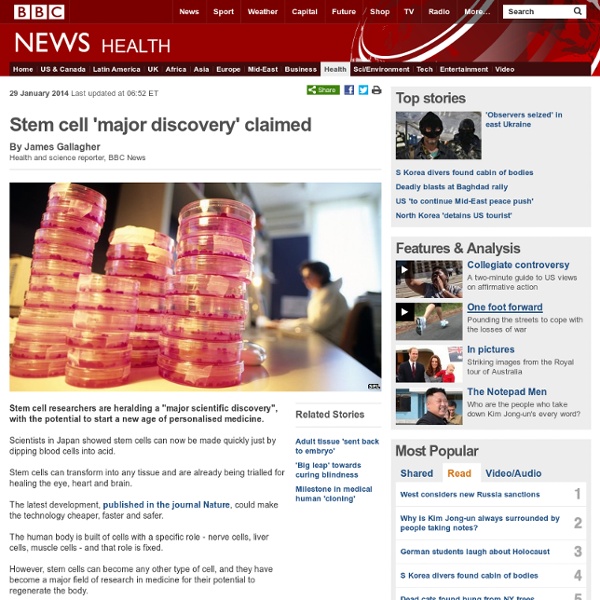Stem cell 'major discovery' claimed

Your Tears Hold Emotions at the Microscopic Level
Remember back when we talked about water? Do you remember Dr Emotos studies about how sensitive water is when emotions are projected onto it? Well a photographer named Rose-Lynn Fisher captured photographs of tears at microscopic levels and she found out something that will blow your mind! First of all if you haven’t seen Spirit Science 20, check it out here now! According to various studies there are three types of tears. Rose-Lynn Fisher took electron microscopic pictures of different types of dried tears and once you see these pictures you will see right away that there is a big difference between the different emotions projected onto the water of the tears. Tears of Change Tears of change, photo © Rose-Lynn Fisher, courtesy of the artist and Craig Krull Gallery, Santa Monica, CA Tears of Grief Tears of grief, photo © Rose-Lynn Fisher, courtesy of the artist and Craig Krull Gallery, Santa Monica, CA Tears of Ending and Beginning Tears of Laughter Orion Tears Basel Tears Isn’t that powerful?
Human Cells have Electric Fields as Powerful as Lighting Bolts -A Galaxy Insight
Using newly developed voltage-sensitive nanoparticles, researchers have found that the previously unknown electric fields inside of cells are as strong, or stronger, as those produced in lightning bolts. Previously, it has only been possible to measure electric fields across cell membranes, not within the main bulk of cells, so scientists didn't even know cells had an internal electric field. This discovery is a surprising twist for cell researchers. Scientists don't know what causes these incredibly strong fields or why they' are there. But now using new nanotools, such as voltage-sensitive dyes, they can start to measure them at least. Researchers believe they may be able to learn more about disease states, such as cancer, by studying these minute, but powerful electric fields. University of Michigan researchers led by chemistry professor Raoul Kopelman encapsulated voltage-sensitive dyes in polymer spheres just 30 nanometers in diameter. Posted by Rebecca Sato Related Galaxy posts:
Pennywise and pound-foolish: misidentified cells and competitive pressures in scientific knowledge-building.
The overarching project of science is building reliable knowledge about the world, but the way this knowledge-building happens in our world is in the context of competition. For example, scientists compete with each other to be the first to make a new discovery, and they compete with each other for finite pools of grant money with which to conduct more research and make further discoveries. I've heard the competitive pressures on scientists described as a useful way to motivate scientists to be clever and efficient (and not to knock off early lest some more dedicated lab get to your discovery first). This week, on NPR's Morning Edition, Richard Harris reported a pair of stories on how researchers who work with cells in culture grapple with the problem of their intended cell line being contaminated and overtaken by a different cell line. One of the worst cases involves a breast cancer cell line called MDA-435 (or MDA-MB-435). This may all come down to money.
Related:
Related:



